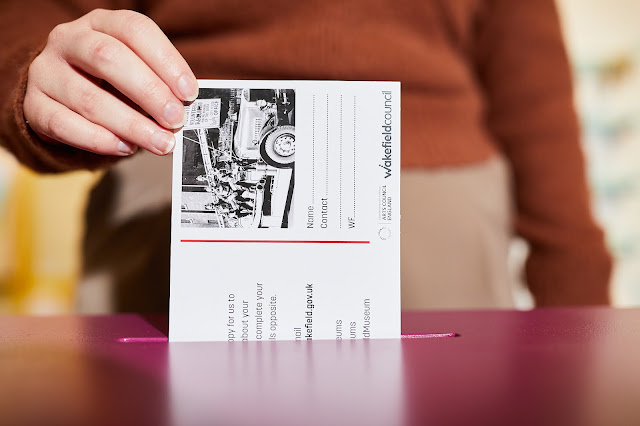After our previous blog post on ‘What is Oral History?’,
you might be wondering where to start collecting your own stories! Here's How to Do Oral History - A Guide.
In her final blog, Lydia challenges you to bring out
your inner historian and collect your own oral histories. They could even feature
in the Moving
Stories exhibition…
As part of the New Library and Museum project, Wakefield Museums and Castles are reviewing their current oral history archives and looking to interview more members of the public. Moving Stories, the new exhibition at Wakefield Museum, has created a perfect opportunity to share some of these oral histories with local people.

One of Tom Bailey's drawings on display in the Moving Stories exhibition
Have you ever wanted to ask a relative what it was
like to grow up in Wakefield or what it was like to immigrate to the area from
another country? You may have a neighbour who was part of the mining industry
or worked in one of the liquorice factories. You may know someone who has been
involved with Wakefield Pride or the Rhubarb Festival.
In our previous blog posts, we’ve explored Sue Riley’s memories of creating drag outfits. We also explained just what an oral history is. Now, we
are giving you the tools to record your own oral histories
Want to get started? Here’s our top tips for collecting oral histories!
 |
| Some gents having a chat in Fryston, taken by Jack Hulme between 1935 and 1955 |
Top Tips for doing Oral Histories
Choose a comfortable and safe space when conducting
the interview – often, it is best to use the interviewee’s home or an area that
is familiar to them.
It is also useful to choose somewhere with little to
no background noise (if possible). Remember to mute your phone!
Think about how you communicate with the other
person – a little bit of encouragement goes a long way for their confidence. Think
about your eye contact, body language and other visual cues. There are lots of
ways to show that you’re interested without interrupting or breaking the flow
of their story.
Using a mix of specific and more open questions allows
for insightful discoveries. It is always a great idea to prepare some questions
while allowing room for the conversation to develop naturally.
A response may spark a new question in your head,
but it is important not to interrupt. Listen closely and take notes of any
points you would like to circle back to and expand on.
Remember to focus on their personal experience! It
is easy for us to discuss an experience or how it affected other people rather
than reflect on our feelings. Try and bring the interviewee back to their own
position in these circumstances.
In the video above, Jo talks about her experience of doing 'Selfie Pantomimes' during the COVID-19 Lockdowns. This story would be hard to demonstrate with an object, but comes to life in Jo's Oral History recording!
What are the benefits of Oral Histories?
Oral histories bring history and museum collections
to life.
Providing a human angle to a time in history can
make it easier for people to relate, connect, or empathise with the stories. Hearing
a person’s story in their own words and dialect can be really moving and
revealing, and you get a sense of their personality and character.
Steph Webb, Senior Officer for Curatorial and Exhibitions
with Wakefield Museums and Castles, particularly loves hearing people’s accents
and dialects in oral history. She says it helps establish a sense of place and
gives a powerful feeling of authenticity. It’s also what is so fantastic about
the current Moving Stories exhibition.
Oral histories can help address the problems with
museum collections and tell stories that aren’t represented or have previously
been hidden. Sometimes, physical objects on specific topics are hard to find. An
oral history can allow you to still capture and share the story even where you don’t
have the objects.
What are the challenges of Oral History?
While it is always interesting to hear how someone
remembers an event or story, we have to remember that memory is subjective, so
it may not always be 100% accurate.
An important aspect to remember is that not everyone
realises their story is important or worth sharing. They believe they have
nothing interesting to say and are reluctant to share their experience, even
when it is exactly what we are looking for!
Similarly, some people can be hesitant to share
their stories, and this could be for many reasons. Maybe this will be the first
time sharing it, they may not be sure about how you will tell their story
afterwards. Perhaps they just aren’t confident speaking to others.
Building trust and rapport with the interviewee is essential to get the best out of your oral history recording.
 |
| A visitor writing their story onto a postcard and submitting it at the Moving Stories exhibition at Wakefield Museum |
Get in touch
Have you got a story you’d like to share? Drop us an email at museums@wakefield.gov.uk. We’d love to hear from you!Why not visit the Moving Stories exhibition at Wakefield Museum for some inspiration?

No comments:
Post a Comment
We would love your comments - though they may take a day or two to appear.